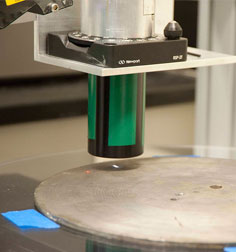
Recovering Sounds with IRENE
The leading edge of preserving the content on endangered historic sound recordings is found in the world of high energy physics.
Using insights from his work on designing instruments for detecting subatomic particles, Carl Haber and his colleagues at the U.S. Department of Energy’s Lawrence Berkeley National Laboratory developed a new method called IRENE beginning in 2003.
IRENE (Image, Reconstruct, Erase Noise, Etc.) consists of instruments for making high-resolution images of the surface of sound recordings without touching them and software for converting those images to digital sound files. The system can retrieve sound safely from historical recordings made on a wide variety of media regardless of their condition.
IRENE has evolved in collaboration with the Library of Congress, the National Endowment for the Humanities, and the Institute of Museum and Library Services.
Collaborating scientist Earl Cornell adjusts IRENE to scan a recording from 1881 at Lawrence Berkeley National Laboratory



